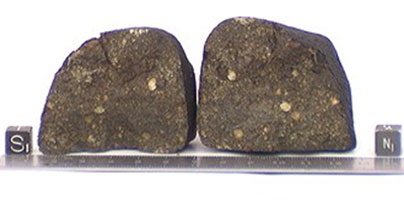[/caption]
Astronomers studying ways to deal with incoming near-Earth asteroids (NEA) that might be on a collision course with our planet want to know in detail what these space rocks are made of. The better they "know the enemy" the better they can come up with ways to destroy or change the course of NEAs. Since we've only studied a couple of asteroids up close with spacecraft, the best way to learn more about the composition of asteroids should be fairly easy: just look at meteorites that fall to Earth, which are small chunks of asteroids. But in doing so, researchers discovered quite a huge discrepancy. The vast majority of asteroids that whiz by Earth are of a type that matches only a tiny fraction of the meteorites that most frequently hit our planet. This difference has had astronomer scratching their heads. But a team of researchers has now found what it believes is the answer to the puzzle. The smaller rocks that most often fall to Earth, it seems, come straight in from the main asteroid belt out between Mars and Jupiter, rather than from the near-Earth asteroid population.
The researchers studied the spectral signatures of near-Earth asteroids and compared them with spectra obtained on Earth from the thousands of meteorites found on Earth. But the more they looked, the more they found that most NEAs -- about two-thirds of them -- match a specific type of meteorites called LL chondrites, which only represent about 8 percent of meteorites.
"Why do we see a difference between the objects hitting the ground and the big objects whizzing by?" asked Richard Binzel, a professor from MIT. "It's been a headscratcher." As the effect became gradually more and more noticeable as more asteroids were analyzed, "we finally had a big enough data set that the statistics demanded an answer. It could no longer be just a coincidence."
Way out in the main belt, the population is much more varied, and approximates the mix of types that is found among meteorites. But why would the things that most frequently hit us match this distant population better than it matches the stuff that's right in our neighborhood?
An obscure effect that was discovered long ago was recently recognized as a significant factor in moving asteroids around and putting them on a fast track towards the inner solar system, called the Yarkovsky effect.
This effect causes asteroids to change their orbits as a result of the way they absorb the sun's heat on one side and radiate it back later as they rotate around, which alters the object's path. This effect acts much more strongly on the smallest objects, and only weakly on the larger ones.
So, for smaller sized space rocks-- the kinds of things that end up as typical meteorites -- the Yarkovsky effect plays a major role, moving them with ease from throughout the asteroid belt on to paths that can head toward Earth. For larger asteroids a kilometer or so across, the kind that we worry about as potential threats to the Earth, the effect is so weak it can only move them small amounts.
The new study is also good news for protecting the planet. One of the biggest problems in figuring out how to deal with an approaching asteroid, if and when one is discovered on a potential collision course, is that they are so varied. The best way of dealing with one kind might not work on another.
But now that this analysis has shown that the majority of near-Earth asteroids are of this specific type -- stony objects, rich in the mineral olivine and poor in iron -- it's possible to concentrate most planning on dealing with that kind of object, Binzel says. "Odds are, an object we might have to deal with would be like an LL chondrite, and thanks to our samples in the laboratory, we can measure its properties in detail," he says. "It's the first step toward 'know thy enemy'."
News Source:
MIT
 Universe Today
Universe Today
